Intel SSD 730 (480GB) Review: Bringing Enterprise to the Consumers
by Kristian Vättö on February 27, 2014 12:00 PM EST- Posted in
- Storage
- SSDs
- Intel
- Intel SSD 730
Random Read/Write Speed
The four corners of SSD performance are as follows: random read, random write, sequential read and sequential write speed. Random accesses are generally small in size, while sequential accesses tend to be larger and thus we have the four Iometer tests we use in all of our reviews.
Our first test writes 4KB in a completely random pattern over an 8GB space of the drive to simulate the sort of random access that you'd see on an OS drive (even this is more stressful than a normal desktop user would see). I perform three concurrent IOs and run the test for 3 minutes. The results reported are in average MB/s over the entire time. We use both standard pseudo randomly generated data for each write as well as fully random data to show you both the maximum and minimum performance offered by SandForce based drives in these tests. The average performance of SF drives will likely be somewhere in between the two values for each drive you see in the graphs. For an understanding of why this matters, read our original SandForce article.

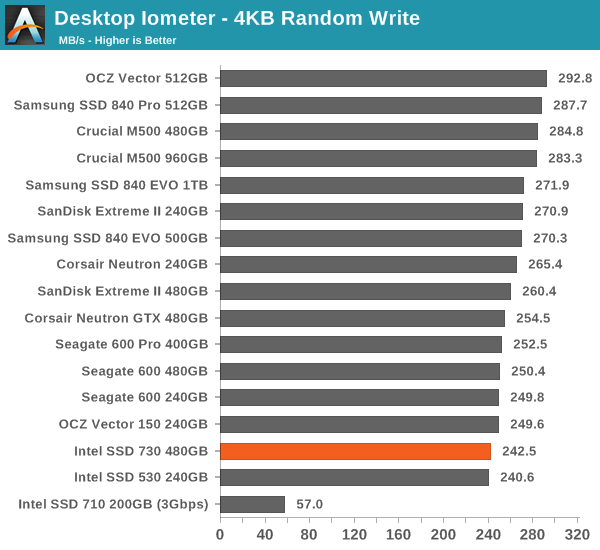
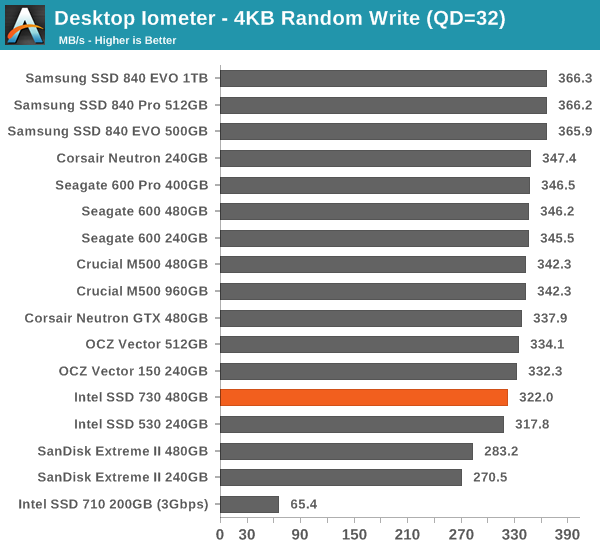
The SSD 730 isn't the fastest in peak performance because that's irrelevant in the enterprise space. We are still looking at decent random write performance and the random read performance is actually surprisingly good.
Sequential Read/Write Speed
To measure sequential performance I ran a 1 minute long 128KB sequential test over the entire span of the drive at a queue depth of 1. The results reported are in average MB/s over the entire test length.
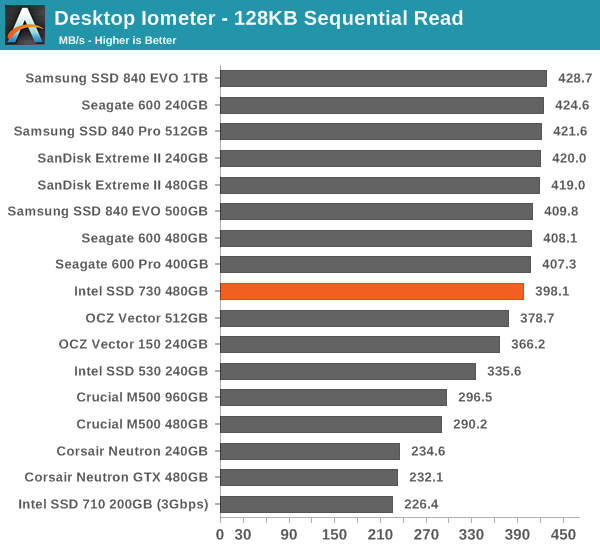
The same goes for sequential performance: the 730 is an average performer with focus on consistency.
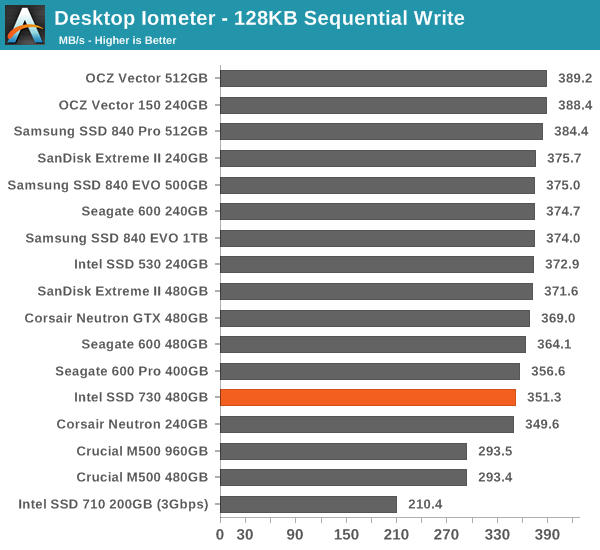
AS-SSD Incompressible Sequential Read/Write Performance
The AS-SSD sequential benchmark uses incompressible data for all of its transfers. The result is a pretty big reduction in sequential write speed on SandForce based controllers.
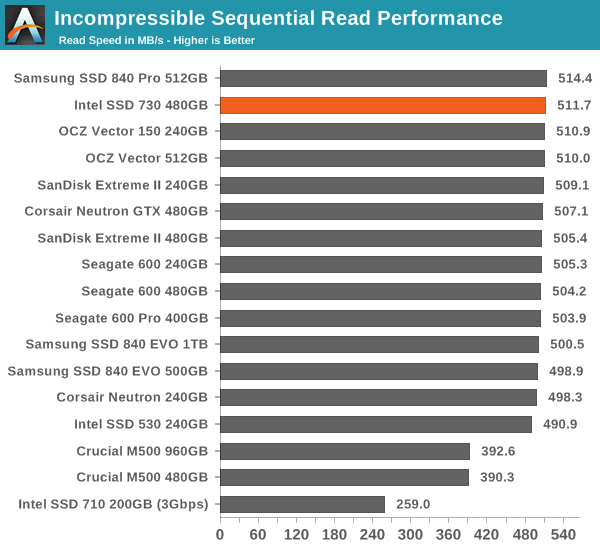
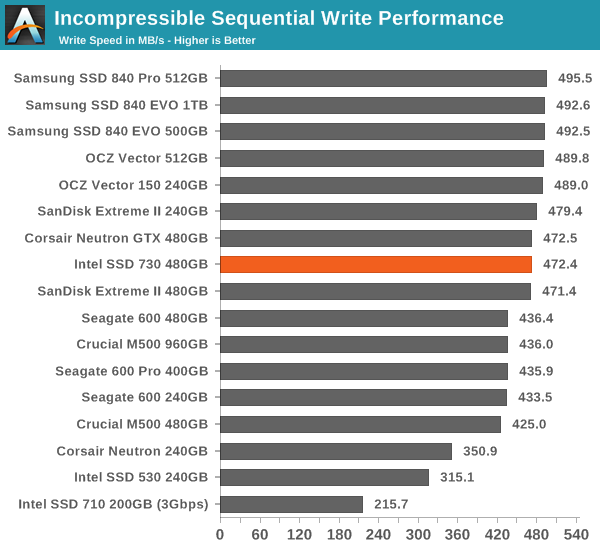










96 Comments
View All Comments
Mr Perfect - Friday, February 28, 2014 - link
Because it's edgy and cool, and what the youf are looking for in a SSD... Or at least according to the guys in marketing it is.arvivaz - Monday, March 3, 2014 - link
Not satanic. Just a skull. But its really witty. The skull is tilted like its looking at a PC screen and that looks like a smile. Skin's blown away from the power of the hardware, I suppose. Note the electrical/electronic symbols hidden in the skull. Pretty good.star-affinity - Monday, March 17, 2014 - link
What's so satanic about it? I think it resembles quite well the skull we all carry around…amddude10 - Friday, November 28, 2014 - link
I bought one of these because of its wear tracking/ drive monitoring features, significantly better than crucial m500 power loss protection, high endurance, and long warranty. I didn't buy this SSD for gaming, yet I find the skull endearing. This drive certainly seems likely to live up to the "hardcore" image of the skull, at least in terms of reliability/durability.danjw - Thursday, February 27, 2014 - link
No support for built in encryption, kills that product in my eyes. Sure, the consistency is nice, but I don't see ever using drives that don't have encryption capabilities. That, said I am much more security conscious than most consumers. I always secure wipe drives once I retire them. I care enough to make sure my drives have the on drive encryption enabled. These are for the people that think over much of the Intel brand and think Windows Firewall and Security Essentials are actually a good security choice.PEJUman - Thursday, February 27, 2014 - link
I say having common sense is the best security choice, more so than any specific program/brand of firewall-antivirus.I see the market for this SSD as near workstation class desktops @ semi-pro/pro setting (think small business). you would be secured behind your IT (camera, chassis intrusion alarm, etc). Not to mention your data on the SSD will be server-backed, negating most of the benefit of encryptions.
I honestly think Intel is no longer chasing true consumer/enthusiast (or anyone with price/performance considerations).
DesktopMan - Thursday, February 27, 2014 - link
Since this SSD isn't optimized for mobile, encryption doesn't make all that much sense due to limited ATA password support on mainstream motherboards. Also makes sense that they want to differentiate from the enterprise drive.beginner99 - Thursday, February 27, 2014 - link
Exactly. Encryption is more relevant in laptops and this clearly isn't a laptop drive. That being said I do not see a market for this drive. It's a tiny, tiny niche. The 840 Evo is faster and way cheaper, the M500 is like half the price albeit slower it has more features and I doubt one notices much difference in normal usage scenarios.zyxtomatic - Thursday, February 27, 2014 - link
You can also use the whole disk encryption option in your OS (Windows Bitlocker, Mac FileVault, etc) if your drive doesn't have hardware encryption. The performance hit really isn't that bad, and it protects your data just as well as hardware encryption does. I've been using it on my work and personal laptops for years and it's never been a problem.chrnochime - Saturday, March 1, 2014 - link
And the Evo is in a long line of SSDs that have consistently have drive failures for users within the span of several months, as seen on user reviews. Who gives a shit about faster when it's like playing lottery with using the drive anyway.